The Three R's: Repairs, Restorations and Rehabs
By Brett Martin
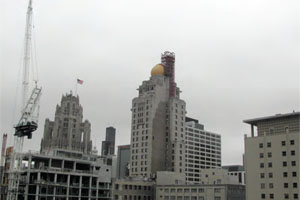
Ken Oatman is a third-generation bricklayer who cut his teeth in traditional commercial masonry in Texas. Seven years ago, after relocating to Pennsylvania, he switched his focus to historic renovations. Now, as the president of Oatman Masonry & Restoration in York, Pa., he repairs historic chimneys (which often deteriorate faster than the rest of the building) and retrofits buildings so they can be reused for new, commercial purposes.
"I've always loved old buildings, and I'm enthralled with brickwork, so I love the work," he said. "I like creating new functions for the buildings."
Although the buildings have detailed masonry features, Oatman said he hasn't had trouble matching the craftsmanship. "The problem is not matching the work," he said. "The problem is matching the materials."
Stephan Niewiadomski, vice president of National Restoration Systems in Rolling Meadows, Ill., which handles commercial renovation work on hotels and universities, among other projects, said he uses a handful of quarries around the country to find the best possible material matches for existing buildings.
The company's expertise in renovations enables it to find matching materials, Niewiadomski said. That expertise also comes in handy when bidding on renovation projects. "The more experience you have and the more unique projects you work on, the more knowledge you have to draw on," he said.
Since every job is so different, it's difficult to develop a hard and fast formula for determining a project's cost, Oatman said.
"We try to be creative and innovative to be cost-effective, and we do a good job," he said. His method seems to be working. Oatman said he gets 80 percent of the jobs he bids on, and he also has repeat clients.
According to Andrew deGruchy, president of deGruchy Masonry Inc. and LIME WORKSTM, a specialty materials supply company in Quakertown, Pa., since restoration and renovation work focuses on the details, all jobs - regardless of the size - come down to this meticulous work.
"Every job we do is a small, intensely detailed job," he said. "We put out bids from $10,000 to $1 million, but even the largest project really breaks down to concentrating on what the requirements are for restoring some detail of historic masonry; therefore every part of each job is small."
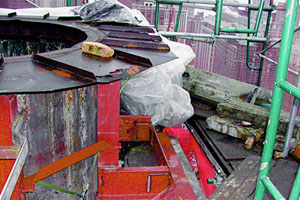
"The great thing these days is you have a lot of custom mortars made," Niewiadomski said.
At the other end of the spectrum, many masons prefer to make their own mortar. For instance, deGruchy completes a mortar analysis and then duplicates the original mortar in color, composition, texture and tooling to match the surrounding mortar. He also makes sure that the new mortar is compatible with the bedding mortar.
"Matching mortar colors is pretty tough," said Oatman, who also mixes his own mortars. "Some companies claim they can match mortar perfectly. I have yet to see that."
He starts by making a mortar sample, which he tests on a two-foot by two-foot section of the wall in a conspicuous area so it's easy to see.
"We do a lot of sample testing. I'm not going to say we get a 100-percent match; I encourage 100 percent, but we get as close as we can," he said.
"When you build an addition, the new brick will not match the existing brick; the color may be slightly off, so we come in and match the brick," explained Jennifer Schilpp, office manager of Color Match Masonry in Baltimore. "It's very cost-effective, compared to when you have repairs done."
Stains also can fix walls damaged by improper cleaning, pressure washing or removal of graffiti, Schilpp said.
Steve Homolka, senior vice president of BrickImaging Inc. in Fort Collins, Colo., agreed, noting that staining can add a single color to a wall, or multiple colors to match a pattern.
"We can take outdated looking masonry that's 30 to 40 years old and make it look like new without the extreme expense of replacement," Homolka said. "We can take the brick from any color they have to any color they want."
BrickImaging handles staining jobs, mostly of commercial buildings, all over the country. Approximately 60 percent of the company's work is in new construction, Homolka said. Masonry and brick companies hire BrickImaging to restore, enhance or repair colors on masonry walls.
"Some manufacturers keep us on their speed dial," he joked. Staining can fix many dye problems, where bricks have color inconsistencies caused by the manufacturing process.
Homolka calls staining "invisible works of art" since the process doesn't leave any telltale signs. "We'll give people the address of a building we worked on," he said. "They'll go look at it and say, 'I can't see anything.' They think they have the wrong building, but we tell them, 'You're not supposed to see anything. That's the whole point.'"
Some mason contractors prefer to handle the staining themselves. Oatman said he's able to stain walls as good as any brick staining companies, which saves him money.
"I use a masonry stain from Sherwin-Williams tinted closely to samples I submit, and then I customize them with tints to fine tune the final stain to match the actual job," Oatman said. "It is time consuming, as it is somewhat trial and error, but it is a wonderful solution to the mismatch problem."
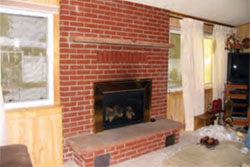 BrickImaging Project 1 - Before | 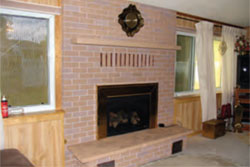 BrickImaging Project 1 - After |
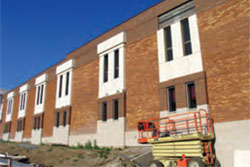 BrickImaging Project 2 - Before | 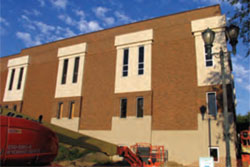 BrickImaging Project 2 - After |
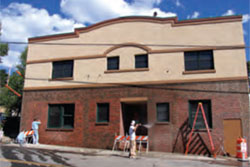 BrickImaging Project 3 - Before | 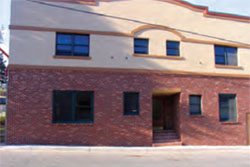 BrickImaging Project 3 - After |
| Photos courtesy of BrickImaging. | |
"The original architects didn't think of people working on these locations years later," Niewiadomski said. "To get at some of these items, the scaffolding contractors dream up new ways to do things."
National Restoration Systems recently handled the restoration of a dome and worked on a chimney for the InterContinental Hotel in downtown Chicago - work that didn't start until the 40th floor. The project entailed installing tube and clamp scaffolding from four different roofs on three elevations to access the chimney. The scaffolding also had to support the 600-pound stones the workers were taking off the chimney.
"There are many challenges to figuring out access to the worksite and how to work safely," said Frank Jamison, president of Jamison Masonry Restoration LLC in Oreland, Pa. The company handles a great deal of masonry repair work and historic building renovations. "On churches, the steeple is the highest part of the building and takes a beating from Mother Nature. You have to create a means to support the structure."
He sometimes works with an engineer to determine the best course for stabilizing a building or parts of a building. "It's almost like you have to do forensic work to come down to a structural level that's sound," Jamison said.
Structural work is done only when structural failures are causing a problem, deGruchy said.
"Each component of the restoration is not difficult in itself. The place where the hardest work is found is in the diagnosis of what is the root cause of the problem, and the interpretation of what should effectively be done while following [the architect's] original intent for the architectural details of a building," deGruchy said. "We don't want to change the building, but only touch it in the areas where our intervention is needed and leave the rest alone."
"We were called in to undo what [another contractor] called repointing and get various details throughout the building back in order," deGruchy said. "You have to have a lot of patience to see a mess like this ... and not walk away. It is a challenge to reverse the mess someone else created and help the building owner get back on track with the conservation of their historic structure."
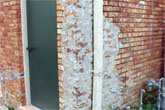 deGruchy Project Before | 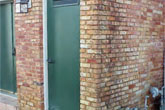 deGruchy Project During | 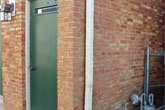 deGruchy Project After |
| Photos courtesy of deGruchy Masonry, Inc. | ||
deGruchy removed the surface treatment that the contractor had put on the wall, then patched and replaced brick as needed with his custom formulated patch material. He made the color matches for the mortar, brick patch and stains. With more than 25 years of experience restoring historic masonry buildings, deGruchy said he's had every type of curveball thrown at him regarding "botched up" historical buildings, and he's been able to successfully repair them.
"One huge challenge is knowing that there are more fly-by-night masons saying they do restoration ... and calling it the same as what we do," he said. "Sometimes their work is not so glaringly bad, but often it is still just as devastating to the long-run conservation of the structure."
About the Author
Brett Martin is a freelance writer located in Shakopee, Minn. with several years of construction and writing experience.


















